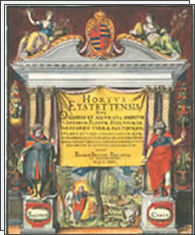 IL COMMENTARIUM È PARTE INTEGRANTE DELL'HORTUS EYSTETTENSIS, IN QUANTO RIPORTA SAGGI UTILI ALLA COMPRENSIONE, SIA SOTTO IL PROFILO SCIENTIFICO-BOTANICO CHE ARTISTICO, LIBRARIO E BIOGRAFICO. IL COMMENTARIUM È PARTE INTEGRANTE DELL'HORTUS EYSTETTENSIS, IN QUANTO RIPORTA SAGGI UTILI ALLA COMPRENSIONE, SIA SOTTO IL PROFILO SCIENTIFICO-BOTANICO CHE ARTISTICO, LIBRARIO E BIOGRAFICO.
Si tratta di un importante contributo che offre un'interpretazione dei contenuti dell'opera e una migliore comprensione del contesto storico-culturale in cui è nata l'opera stessa, con le sue finalità e l'iter processuale.
È frutto di autori italiani e tedeschi, tutti specialisti del settore, di cui più avanti sono date le note bio-bibliografiche.
 Presentation Presentation
The task of recovering and promoting the literary heritage of the past in the field of plant culture continues with the publication, in facsimile format, of the monumental herbarium "Hortus eystettensis" by Basilius Besler, a priceless botanical work published in the early 17th century. As stated on several occasions, Aboca Museum intends to offer plant lovers, specialists and book collectors the reproductions of some of the most interesting and rare texts in the history of botany, especially those whose medical/pharmaceutical subject matter is in line with the company philosophy. In short, we aim to revive the emotions of an age-old tradition that has never died out, although it has been weakened by competition from increasingly technological knowledge. At the same time, we also wish to promote the skilful process of reproducing the forms and colours of plants. Only great, yet often unknown artists have managed to express this constantly evolving illustrative technique to the full. Besler's historic herbarium, because that is what it is, is a milestone in the history of botany, rich in species, many of which can be classed as medicinal. It does not do it justice to say that it merely overwhelmed us with its breathtaking beauty and fresh By painstakingly reprinting the entire 1613 edition, taking into account the form, thickness, weight and grooves of the paper, ribbing of the spin, hand binding, dry impressions and numerous other small details that characterise the original, we aim to make the reader relive the Jeep emotions that are aroused when turning the pages of a book like this, a real book of nature. This commentary is an integral part of the book, although it also constitutes a modern adaptation of the "Hortus eystettensis" in its own right. It makes it possible to interpret and understand the contents, as well as to place the work in the historical/cultural context in which it was born, thanks to the coordinated contributions of a number of specialists. Besler's herbarium almost symbolically represents the passage from a culture embedded in classicism to a more modern vision, more in keeping with the natural reality of the world. The flower and its colour, in all its possible forms and shades, in keeping with the nature that surrounds us, are at the centre of the author and artist's attention. The herbarium seems to have been created in order to celebrate the variety of forms (of which there are so many today), the life force of the earth. In short, it is a triumph of colour and form, in which the "viriditas", the soul of the plants of Hildegardian memory, is at the centre of attention, enhanced by the bright colours of the flowers and their meticulous illustration.
[..]
Valentino Mercati
Presidente di Aboca Museum
|
INDICE
Presentazione
di Valentino Mercati
L'esemplare di Eichstätt dell'Hortus Eystettensis del 1613
di Klaus Walter Littger
Da Cratevas a Besler: breve storia egli erbari figurati dall'origine al XVI secolo
di Alessandro Menghini
Basilius Besler - Speziale e scienziato della natura di Norimberga
di Wolf-Dieter Muller-Jahncke
Disegni, incisioni e colori dell'Hortus di Eichstätt
di Duilio Contin
Le piante dell'Hortus Eystettensis - Percorso botanico tra storia e cultura attraverso le stagioni
di Werner Dressendörfer
Primavera (tavole 1-134)
Estate (tavole 135-318)
Autunno (tavole 319-360)
Inverno (tavole (361-367)
Appendici: Le dediche di Besler
_______
STRUTTURA DEL COMMENTARIUM
Tutti i saggi ivi contenuti sono trilingui, in italiano, tedesco e inglese. Dopo la Presentazione dell'Hortus Eystettensis, ad opera di Valentino Mercati, Presidente di Aboca Museum, segue il saggio di Klaus Walter Unger, L'esemplare di Eichstatt dell'Hortus Eystettensis del 1613, che ne spiega le varie edizioni e la concezione generale. Quindi Alessandro Menghini con il saggio Da Cratevas a Besler: breve storia degli erbari figurati dall'origine al XVI secolo, traccia la storia del genere dall'antichità (epoca tardo-antica) al primo Seicento di Besler.
Wolf-Dieter Meiller-Jahncke, poi, incentra la sua attenzione su Basilius Besler, speziale e scienziato della natura di Norimberga, seguito da Duilio Contin che analizza Disegni, incisioni e colori nell'Hortus Eystettensis.
Il Commentarium passa quindi in rassegna
tutte le piante, tutte le 367 illustrazioni
dell'Hortus Eystettensis, una per una con
testo trilingue a fronte, contenente le attuali conoscenze scientifiche, insieme con quelle storiche e aneddotiche: una galleria di emozionante bellezza, illuminante chiarezza e quanto mai piacevole, sorprendente lettura.
Un esempio soltanto: «...il singolare nome tedesco "Tausendgffidenkraut" (erba dei mille fiorini o monete d'oro) deriva dall'antica denominazione botanica Centauria che significa proprio pianta del centauro, ma che fu intesa dal popolo come centum aurum, cento monete d'oro, e fu poi aumentata con l'inflazione...».
Segue la bibliografia; poi l'elenco alfabetico
con denominazione moderna delle specie
raffigurate nelle tavole dell'Hortus Eystettensis;
infine le appendici contenenti le dediche del Besler alla prima e alla seconda edizione dell'opera – dediche interessanti sotto il profilo storico – ancora una volta trilingui dall'originario latino.
|


a cura di Klaus W. Littger, Gernot Lorenz & A. Menghini
COMMENTARIUM
editore PRIULI & VERLUCCA
edizione 2006
pagine 286
formato 29x38
cartonato con sovracoperta plastificata a colori
tempo medio evasione ordine
ESAURITO
150.00 €
150.00 €
ISBN :
EAN :
|
|